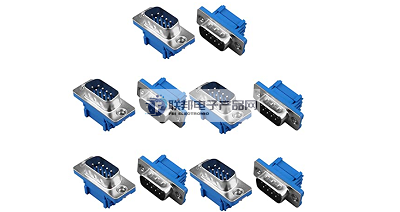Categorization:Product Information
D-sub is short for D-subminiature, a standard for the shape and structure of interfaces, invented by ICC in 1952. Because at that time, this kind of interface is already considered small, so it is named as subminiature. d-sub contains several subcategories, for example, DB25, the first letter D indicates that it belongs to the D-sub, and the second letter B describes the size of the interface - and the number (number of pins) corresponds to the number at the end (A=15-pin, B=25-pin, C=37-pin, D=D=D-sub, D=D-sub, D-sub, D-sub, D-sub, D-sub, D-sub, D-sub, D-sub). = 15 pins, B = 25 pins, C = 37 pins, D = 50 pins, E = 9 pins). Each interface is divided into male (plug) and female (socket). Usage: the most common is DB25 and DE9, personal computer on the typical application is VGA (DA15 female), parallel port (DB25 female), COM serial port (DE9 male), although these interfaces are being replaced by DVI, HDMI, RJ45 Ethernet port and USB. DE9 in the popularity of personal computers after being misread as DB9, and over time DB9 became DE9 alias, for other pin number of D-sub is the same, now with DB to call relatively more. D-sub just describes the connection structure, itself does not define the role of the entire interface or all the pins for the VGA D-Sub: the graphics card to deal with the information ultimately have to be output to the monitor, the graphics card's output interface is the bridge between the computer and the monitor, which is responsible for the display output to the corresponding image signals. CRT monitors because of design and manufacturing reasons, can only accept analog signal input, which requires the graphics card can input the analog signal input. CRT monitors can only accept analog signal input due to design and manufacturing reasons, which requires the graphics card to be able to input analog signals.VGA interface is the interface for outputting analog signals on the graphics card, VGA (Video Graphics Array) interface, 15-pin D-Sub interface (DB15) to achieve. Although LCD monitors can directly receive digital signals, but many low-end products in order to match the VGA interface graphics card, and therefore use the VGA interface. VGA interface is a D-type interface, a total of 15 pins above the empty, divided into three rows, each row of five. VGA interface is the most widely used on the graphics card interface type, the majority of graphics cards with such interfaces. Some do not have a VGA interface with a DVI interface graphics card, but also through a simple adapter will be the DVI interface into a VGA interface, usually no VGA interface graphics card will come with such an adapter. Each pixel on the LCD screen is driven by a specific digital signal, so an LCD display driven by a purely digital signal transmitted through the DVI connector theoretically displays an image without any loss of detail. On the contrary, the analog signal transmitted by the D-SUB interface must be converted to output a digital signal, so image distortion is inevitable. Technology: VGA D-Sub input interface, a total of 15 pins above the empty, divided into three rows, each row of five. CRT color display because of the design and manufacturing reasons, can only accept analog signal input, the most basic contains RGBHV (respectively, red, green, blue, line, field) five components, regardless of what type of access to the interface, its signals at least contain the above five components. The most common interface for most PC graphics cards is the D-15, which is a D-shaped, three-row, 15-pin socket, some of which are useless and vacant on the signal cable used for connection. In addition to these five essential components, the most important thing is that after 96 years of color display is also added into the DDC data component, used to read the display EPROM recorded in the color display brand, model, production date, serial number, index parameters and other information content in order to achieve the PnP (Plug and Play) function required by WINDOWS. Almost all CRTs have this interface. Status: Most computers and external display devices are currently connected through the analog VGA interface, the computer's internal digitally generated display image information, by the graphics card in the digital / analog converter into R, G, B three primary color signals and line, field synchronization signals, signals transmitted through the cable to the display device. For analog display devices, such as analog CRT monitors, the signal is sent directly to the corresponding processing circuit, drive control of the picture tube to generate images. For LCD, DLP and other digital display devices, display devices need to configure the corresponding A/D (analog / digital) converter, the analog signal into a digital signal. After D / A and A/D2 conversion, inevitably caused by the loss of some image details. VGA interface used in CRT monitors is not wrong, but used to connect the LCD and other display devices, the conversion process of the image loss will make the display effect slightly reduced. With the upgrading of external display devices, DVI interface has come into our lives, she will be used in the all-digital lossless transmission of signals, mainly in the high end products.

2, on the federal electronic products network platform related to the introduction and sales of products brief: federal electronic products network - a professional agent / production / sales of all kinds of [connectors | wiring harness | wire and cable products]; if you have a related [connectors | wiring harness | wire and cable products] purchasing / sourcing needs or would like to buy / to understand which connectors | wiring harness | wire and cable products we can provide solutions, please contact our business staff below; If you have related [connectors | harness | wire and cable products] sales / resources and promotion needs, please click on the ¡¡ Business Cooperation ← ¡" and specialists to discuss!